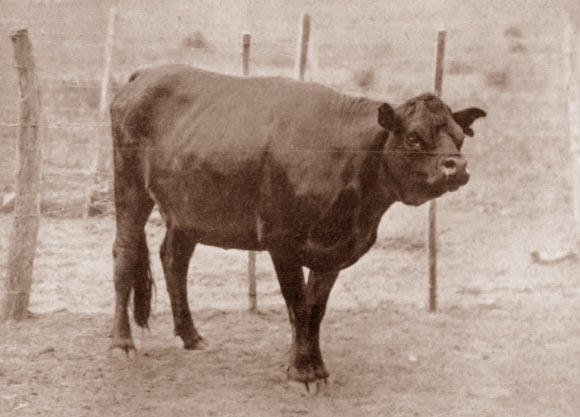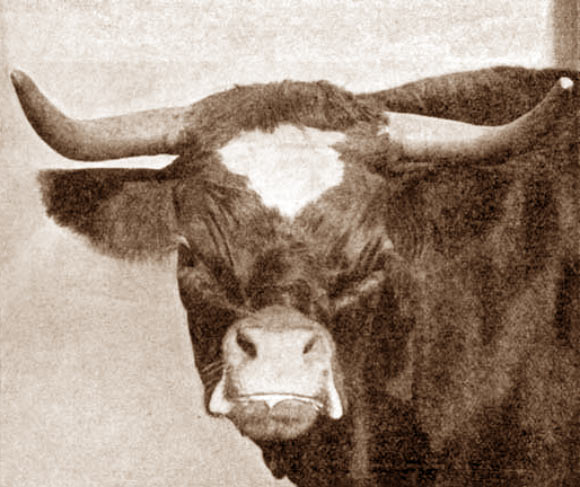New research published in the journal Scientific Reports shows the Niata cow, a now-extinct animal with a short face like a bulldog that fascinated Charles Darwin when he first saw it in Argentina 180 years ago, was a unique breed and — unlike some bulldogs — did not suffer breathing or eating problems because of its peculiar anatomy.

The short-faced Niata cow. Image credit: Journal of Heredity, doi: 10.1093/oxfordjournals.jhered.a110716.
“Very few people know that hundreds of years ago a cow with a face similar to the shape of a bulldog’s existed, called the Niata cow. In our study, we set out to find out more about some of the animal’s anatomical and genetic characteristics,” said co-author Dr. Laura Wilson, a scientist at the University of New South Wales.
“Our principal finding is that the Niata was a taurine breed, unique among cattle,” added senior author Professor Marcelo Sánchez-Villagra, a researcher at the University of Zurich.
Charles Darwin saw this strange cow when he visited the Argentinian Pampas and areas around Buenos Aires in the 1840s.
“On two occasions I met with in this province some oxen of a very curious breed, called nãta or niata,” he wrote.
“They appear externally to hold nearly the same relation to other cattle, which bull or pug dogs do to other dogs. Their forehead is very short and broad, with the nasal end turned up, and the upper lip much drawn back; their lower jaws project beyond the upper, and have a corresponding upward curve; hence their teeth are always exposed.”
“Their nostrils are seated high up and are very open; their eyes project outwards. When walking they carry their heads low, on a short neck; and their hinder legs are rather longer compared with the front legs than is usual. Their bare teeth, their short heads, and upturned nostrils give them the most ludicrous self-confident air of defiance imaginable.”
The Swiss anatomist Ludwig Rütimeyer also wrote about the Niata in his extensive studies of cattle.
The Niata cow is now extinct, but a limited number of skeletons still exist in a few collections around the world. With new tools unavailable to the 19th century researchers, Dr. Laura Wilson, Professor Sánchez-Villagra and their colleagues had the unique chance to study the Niata’s anatomy.
“Until this paper, no attempt to use new and useful methods to understand the anatomy and the evolution of this peculiar cow has ever been made,” Professor Sánchez-Villagra said.
“We used genetics, non-invasive imaging and engineering-inspired biomechanical analyses — tools unavailable at Darwin’s time.”
The team confirmed Charles Darwin’s suggestion that this extinct kind of cattle is a true breed, with unique cranial features.
“A true breed is a kind which is preserved over time in its features and can be distinguished from other breeds — even if crosses with other breeds do occur,” Dr. Wilson said.
“We now also know that the Niata was a taurine breed, unique among cattle because of its short snout and underbite — an anatomy that resulted in differences in the way some of the mechanics of feeding operated.”
Specifically, the anatomical analyses showed that although the face of the Niata was shortened and there was an underbite, the nose regions of the cow were not really impacted by these changes, and the Niata, in contrast to extreme cases with some bulldogs, did not suffer problems with breathing.
The researchers also used state-of-the-art computational modeling techniques to see whether the short face affected how well the Niata could chew food compared to other cattle, showing that during feeding the animal experienced smaller amounts of stress on its skull bones.
“The Niata cow represents an example of extinction of rare breeds. Understanding aspects of its biology allows scientists to better understand how threatened species may be supported,” Dr. Wilson said.
“While we don’t really do not know why the Niata went extinct — detailed studies of its populations over time do not exist — we can make good guesses. We now know that in spite of the singularity of the Niata, this cow was able to eat and live like any other cow.”
“Its extinction was then not the result of being unfit — instead, its extinction in Argentina occurred in parallel with the intensification of cattle raising and with the search for the optimal breed. This meant that fewer breeds were exploited and many became extinct.”
“This has happened with many species of domesticated animals, which has resulted in a decrease of genetic and morphological diversity in the animals closest to our lives,” Professor Sánchez-Villagra said.
_____
Kristof Veitschegger et al. 2018. Resurrecting Darwin’s Niata — anatomical, biomechanical, genetic, and morphometric studies of morphological novelty in cattle. Scientific Reports 8, article number: 9129; doi: 10.1038/s41598-018-27384-3








